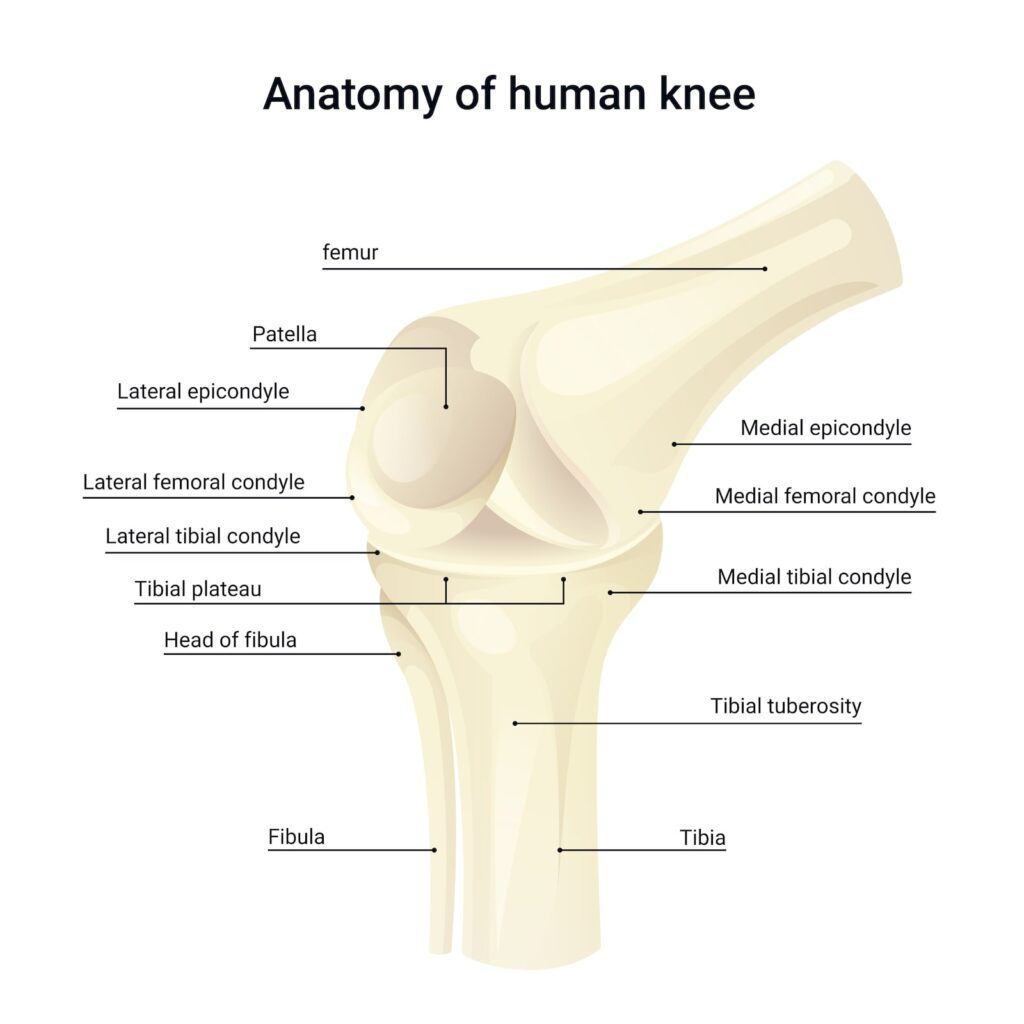Patellofemoral Pain Syndrome (PFPS) is a common knee condition, often associated with runners or jumpers.
In this article, we will evaluate its causes, symptoms, and treatment options. By understanding the mechanics of the knee and addressing the root causes, most people can effectively treat their PFPS without surgery.
What is Patellofemoral Pain Syndrome?

PFPS is pain that occurs around the kneecap (patella). It is sometimes referred to as runner’s knee, jumper’s knee, or chondromalacia patella. The condition is caused by the patella not tracking properly in the groove it is supposed to run in, usually due to tight or imbalanced muscles around the knee, or overuse from repetitive stresses such as running or jumping.
Symptoms of PFPS
The pain associated with Patellofemoral Pain Syndrome is typically located in the front of the knee and presents as a dull ache. It often worsens when walking up or down stairs (particularly descending), kneeling, or squatting.
Prolonged sitting or driving can also lead to increased discomfort, with the knee becoming achy and painful. Relief is generally experienced when the leg is straightened out after a period of rest.
Diagnosis and Imaging
When examining a patient with Patellofemoral Pain Syndrome, tenderness in and around the kneecap is usually observed. Imaging studies, such as MRI, have limited value in diagnosing PFPS and are primarily used to rule out other issues.
It is important to remember that even if an MRI shows arthritis or a meniscus tear, these findings are common in people without knee pain.
A clinical diagnosis of PFPS should be considered if the patient’s symptoms and presentation align with the condition.
Associated Injuries

Patients with patellofemoral pain may also experience other injuries, such as distal ITB pain and fat pad problems. These injuries are typically inflammatory in nature, requiring careful management to avoid exacerbating the condition.
It is important to prioritize the treatment of these associated injuries based on their impact on the patient’s overall function and pain levels.
Treatment Approaches
When devising a treatment plan for patients with Patellofemoral Pain Syndrome, it is crucial to limit the number of exercises to enhance adherence.
Studies show that adherence drops significantly when more than three exercises are prescribed.
To ensure patients can understand and replicate the exercises at home, healthcare professionals should provide clear instructions and demonstrations.
Moreover, it is essential to focus on taking the patient to fatigue during strength exercises. To achieve this, healthcare professionals may need to tweak the exercise program over time, gradually increasing the difficulty or load.
This approach helps patients maintain a consistent routine while still experiencing the benefits of progressive overload.
Treating Patellofemoral Pain Syndrome
The key to treating PFPS is addressing the biomechanics that lead to the patella’s improper tracking. This typically involves:
- Strengthening the quadriceps, hip flexors, and hip abductors.
- Stretching the iliotibial band, hamstrings, and calves.
- Evaluating the feet and considering orthotics if flat feet or hyperpronation are present.
- Using a patellar strap or brace, which may be helpful for some individuals.
Additionally, ice and topical non-steroidal anti-inflammatories, like diclofenac gel, can help alleviate inflammation and pain.
Injections, such as viscosupplementation or steroid injections, may be considered if symptoms do not improve with conservative treatments.
However, they should be used as a temporary measure to allow patients to focus on their exercises and improve biomechanics.
The Role of the Kinetic Chain
While focusing on the knee is essential when treating PFPS, it is equally important to consider the entire kinetic chain.
The position of the patella, femur, pelvis, trunk, and foot all influence the loading and alignment of the patellofemoral joint, making it necessary to address any imbalances or movement dysfunctions throughout the body.
By examining the entire kinetic chain, healthcare professionals can develop a comprehensive treatment plan that addresses the root causes of Patellofemoral Pain Syndrome.
Returning to Sports and Activity
Resting from the activity that caused the pain is essential during treatment.
Once the pain has improved and biomechanics have been addressed, individuals can gradually return to their sport or activity.
Managing Persistent Patellofemoral Pain
When dealing with patients who have experienced persistent patellofemoral pain, it is crucial to listen to their concerns and understand their previous treatment history. In some cases, these patients may have developed neuropathic pain, requiring a combination of mechanical and medical interventions.
Addressing sleep disturbances, improving exercise tolerance, and providing a tailored exercise program can also play a significant role in managing persistent pain.
Surgical Options
Surgery is rarely needed for Patellofemoral Pain Syndrome.
Some surgical approaches involve arthroscopy, realignment of the patella, lateral retinacular release, or tibial tubercle transfer in severe cases of malalignment. However, most cases of PFPS can be resolved with conservative care.
Conclusion
Patellofemoral Pain Syndrome is a treatable knee condition that requires a focus on improving biomechanics through targeted exercises and, when necessary, additional interventions like orthotics or braces.
By following a comprehensive treatment plan, most individuals can successfully manage their PFPS without resorting to surgery.
Managing patellofemoral pain syndrome requires a tailored approach that takes into account the patient’s unique risk factors, movement patterns, and lifestyle factors.
By carefully assessing each patient and developing a targeted treatment plan, healthcare professionals can help individuals with PFPS return to their desired activities with reduced pain and improved function.
By understanding the kinetic chain, associated injuries, and the importance of individualized treatment plans, medical professionals can better help patients overcome this challenging condition and return to their active lifestyles.
proved function, reduced pain, and a better quality of life.
MD, PhD. Physical Medicine & Rehabilitation Physician from São Paulo - Brazil. Pain Fellowship in University of São Paulo.

